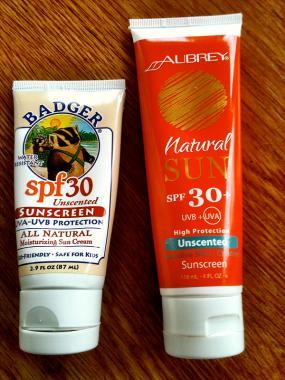Safe, non-toxic sunscreen and how to wear it
Safe, non-toxic sunscreen and how to wear it
Note: this is a reprint of an article I originally wrote for AquaticsFan.com that was also featured on Alameda.Patch.Com.
The 2 sunscreens shown above -- bought at the Alameda Marketplace -- are not inexpensive. At $15 for 3 ounces, you may wonder why my family uses Badger SPF 30 instead of much cheaper chemical sunscreens such as Banana Boat or Coppertone. The reason is simple: the latter 2 brands could be extremely dangerous to your health.
The sun has many benefits. It triggers your body to produce Vitamin D which benefits your bones and immune system. Vitamin D also helps reduce risks of cancer. But prolonged exposure to ultra-violet rays (UVA's) can also cause cancer and needs to be blocked. So if you want to take off your clothes and hat and get out of the shade (to be in the water perhaps) you need skin protection. And when choosing your protection, you certainly don't want to put something toxic on your skin and compound the damage.
There are 3 main types of sunscreen, but only 2 types are available in North America.
Mineral Sunscreens
Mineral sunscreens are usually comprised of zinc-oxide or titanium-dioxide. Remember the lifeguards' "white nose" back in the 1970's? That was zinc-oxide, which is very effective at blocking out UVA's. The drawback with these micro particulars is they can be harmful if they enter your bloodstream -- which shouldn't really happen.
What's amazing is these kinds of sunscreens are not very popular. They only make up 20% of the market and I ***never*** see them in grocery and drugstores. You need to really seek them out, and they cost a lot more. Also, some people think they are stinky. Hardly an excuse to seek out skin cancer instead.
The 2 brands pictured above -- Aubrey Organics and Badger -- fit in this category. We like both but the Badger is less oily. They do a good job at the beach when we are in and out of the water. Other brands on the safe list (check the EWG link below) include: Alba Botanical, Beyond Coastal, Blue Lizard, Goddess Garden, Kiss My Face, MDSolarScience, Trukid, and more.
Chemical Sunscreens
Chemical sunscreens are the norm in the U.S. This is all you will see at Safeway, CVS, or wherever. You know the brands... Banana Boat, Coppertone, CVS, Hawaiian Tropic, Neutrogena, Panama Jack, Rx Suncare, Solar Sense, etc.
Just look at the ingredients. Many of them have Oxybenzone as their most active ingredient which has been linked to hormone disruption (sometimes called "gender benders.") Sometimes you will see this listed as 4-MBC. You want to avoid all contact with these.
Other chemicals are "free radical generators" that cause cellular damage to skin that can lead to cancer. Beware the retinyl palmitate (sometimes called retinol) and benzophenone, which has been identified as one of the most powerful free radical generators known.
More chemicals to avoid are: avobenzone, ethylhexyl p-methoxycinnimate, 2-ethylhexyl salicylate, homosalate, octyl methoxycinnamate, and triethanolamine.
European Sunscreens
The Europeans have concocted a safe recipe of mineral sunscreens that are currently blocked in the United States and Canada.
The FDA will not approve these. As a matter of fact, the FDA's proposed safety regulations for sunscreen has been tied up since 1978!
How to wear sunscreen
First of all -- no matter if you are choosing mineral sunscreen or skin-sizzling chemical sunscreen -- don't do what I see people do every day at the pool: slather or spray it on then get into the pool right away. It won't do you any good because it takes some time for the lotion to activate in the sun and it will just wash off. But worse -- you create a toxic, oily cloud in the water for the rest of us. Nasssty.
Put it on... WAIT A BIT!!... THEN get in the water. And then don't forget to reapply later, because it might only last an hour or two even when applied properly.
Don't get a false sense of security because you slathered on the SPF 100 and think you are good for the day. SPF is very misleading as it is so you might not be getting the protection you think you are getting, especially if you didn't apply enough and evenly. If you are at the beach and getting in and out of the waves, you will need to reapply or your protection will whither away.
Aquatics Fan recommends...
We like the Badger. We have been using it in the surf, before swim practice, on the paddleboards, learning to windsurf, just going out on hikes, and so on. You might have to track it down at your local health store, but it's worth it.
Once you have the right stuff, be sure to apply it properly... don't get in the water too soon... and remember to reapply. Aquatics Fan is also a big fan of beach umbrellas and hats for those rare moments out of the water. Take advantage of the shade when you can and your sunscreen will last longer.
Finally, we need better options. Click the bottom link to sign the petition to get the FDA off their lazy ass and approve the European sunscreens and enact the safety regulations that we need. Maybe then, regular folks will be able to find non-toxic sunscreens at their favorite grocery store.

